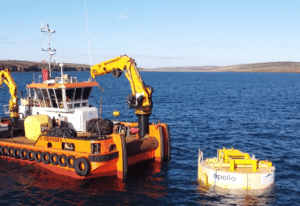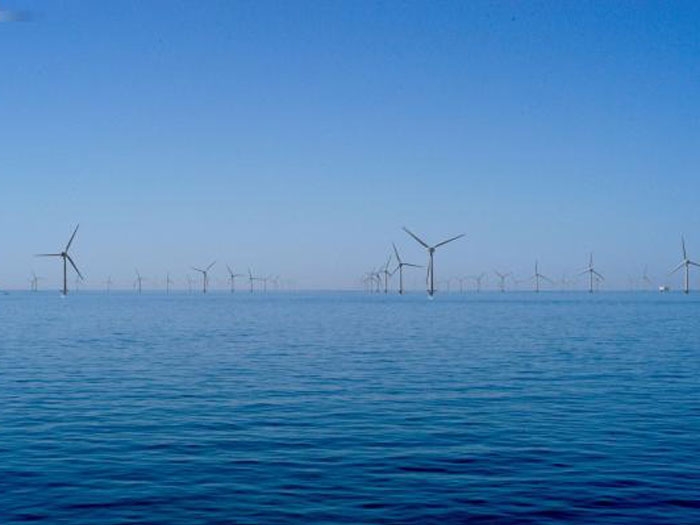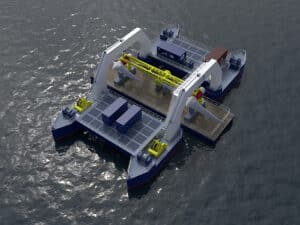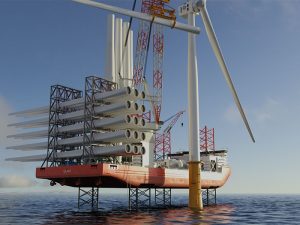
U.S. finally moving ahead on offshore wind?
Written by Marine Log Staff
When complete, Cape Wind would generate 360 MW of electricity
JULY 2, 2014 — After several starts, stops and stalls, offshore wind in the U.S. is starting to pick up a favorable breeze. The U.S. Department of Interior’s Bureau of Ocean Energy Management (BOEM) issued today the Final Sale Notice for Maryland’s offshore Wind Energy Area (WEA) — the last major regulatory step before BOEM can auction the lease areas within the WEA. The auction for the nearly 80,000 acres offshore Maryland will occur on August 19, 2014.
Maryland Governor Martin O’Malley said the announcement was “a tremendous step forward for the U.S. offshore wind industry.” Maryland has outlined plans to generate 20% of its energy from renewable resources by 2022.
“Maryland is a leading force for building a clean and sustainable energy future,” said U.S. Interior Secretary Sally Jewell. “Thanks to Governor O’Malley’s leadership and significant stakeholder involvement through BOEM’s Maryland Intergovernmental Renewable Energy Task Force, we have reached another milestone as we strengthen our nation’s foothold in the new energy frontier.”
The Maryland WEA covers about 94 square nautical miles of ocean beginning 10 nautical miles off the shores of Ocean City, MD. The area is further subdivided into northern and southern lease areas in order to ensure efficient use of the available area and support competition. BOEM has solicited input from developers and the public regarding this area, most recently, in December of 2013, through a Proposed Sale Notice.
Today’s announcement, follows yesterday’s conditional commitment to Cape Wind Offshore LLC by the U.S. Department of Energy of issuing a $150 million loan guarantee to support the construction of the Cape Wind offshore wind project. If constructed, Cape Wind would be the first commercial-scale offshore wind facility in the U.S., with a capacity of more than 360 megawatts (MW) of clean energy off the coast of Cape Cod, MA.
“In just the last year, eight projects in the Department’s Loan Programs Office have become fully operational, including one of the world’s largest operating photovoltaic solar power plants, the world’s largest concentrating solar power plant, and a vital Western transmission line,” said Secretary Ernest Moniz. “These innovative projects are delivering clean, renewable energy for American consumers today and are helping to diversify our energy portfolio. The Department’s loan guarantees have assisted the launch of new industries in the U.S., and today’s announcement of a conditional commitment to the Cape Wind project demonstrates our intent to help build a strong U.S. offshore wind industry.”
The DOE’s announcement is a conditional commitment for a loan guarantee for Cape Wind is a significant step for this first-in-the-nation offshore wind energy project,” said Massachusetts Governor Deval Patrick. “Offshore wind will not only provide a new, clean source of energy for the United States, it will reduce American reliance on fossil fuel, mitigate climate change and jump start a new U.S. industry that will create thousands of clean energy jobs.”
“This funding will help Massachusetts make energy history and continue our leadership as a clean energy jobs hub for the entire nation,” said Senator Edward J. Markey. “This kind of public-private partnership is exactly what these energy funding programs are designed to do, demonstrating leading-edge, potentially planet-saving technologies while creating good American jobs.”
The proposed Cape Wind project would use 3.6-megawatt offshore wind turbines that would provide a majority of the electricity needed for Cape Cod, Nantucket and Martha’s Vineyard, and would create some 400 construction jobs and 50 operations jobs.
The conditional commitment is an important step towards issuing a $150 million loan guarantee to support construction of the project. The DOE will continue to monitor the project’s development and work to reach final agreement before closing the loan guarantee.
Under the proposed financing structure for the Cape Wind project, the DOE would be part of a group of public and private lenders. This co-lending arrangement will help build private sector experience with offshore wind projects in the U.S. while reducing taxpayer exposure.





Leave a Reply
You must be logged in to post a comment.